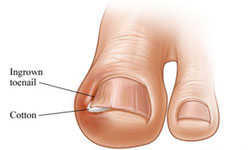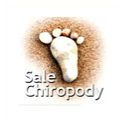Nail Conditions
Nail problems make up about 10 percent of all dermatological conditions. ... Fungal infections cause about half of all nail disorders.Ingrowing Toenail (Onychocryptosis)

What is it? An ingrowing toenail is one that pierces the flesh of the toe. It can feel as if you have a splinter, and can be extremely painful. In more severe cases, it can cause pus and bleeding. Ingrowing toenails most commonly affect the big toenail, but can affect the other toes too. A nail that is curling (involuted or convoluted) into the flesh, but isn’t actually piercing the skin isn’t an ingrowing toenail, but can feel very painful and also appear red and inflamed as well.
Who gets it? Active, sporty people are particularly prone, because they sweat more. Younger people are more likely to get it (as they pick their nails more, compared to older people who may not reach their toes!) Women often develop them as a result of cutting nails too low in order to relieve the pressure and discomfort of an involuted nail.
Is it serious? If left untreated, the infection can spread to the rest of the toe. The quicker you treat it, the less painful the treatment.
What causes it? There are many genetic factors that can make you prone to ingrowing toenails, such as your posture (the way you stand), your gait (the way you walk), a foot deformity such as a bunion, hammer toes or excessive pronation of the feet (when your foot rolls in excessively). Your nails may also naturally splay or curl out instead of growing straight, encouraging your nail to grow outwards or inwards into the flesh. Tight footwear, tight hosiery and tight socks can also push your toe flesh onto the nail so that it pierces the skin, and if you sweat excessively or don’t rotate your footwear, this makes the skin moist, so that it welcomes the nail like a soft sponge. If you have brittle nails with sharp edges or are in the habit of breaking off bits of nails that are sticking out, you’re more likely to get an ingrowing toenail. However, one of the most common causes is not cutting your toenails properly.
What can a podiatrist do? It depends on the severity of your condition. For the most basic painful and irritable ingrowing toenail, your podiatrist will remove the offending spike of nail and cover with an antiseptic dressing. If your toe is too painful to touch, your podiatrist may inject a local anaesthetic before removing the offending portion of nail. If you have involuted nails, your podiatrist may remove the bit that’s curling into the flesh and file the edges of the nail to a smooth surface. If you have bleeding or discharge from an infection, or even excessive healing flesh (hyper granulation tissue) around the nail, you’ll need antibiotics to beat the infection as well as having the offending spike removed. If you are particularly prone to ingrowing toenails from underlying problems such as poor gait, your podiatrist may recommend correction of the underlying problem as well as a more permanent solution to the nail itself, such as partial nail phenolisation (PNA). This is done under a local anaesthetic, where 8-10% of the nail is removed (including the root) so that the nail permanently becomes slightly narrower. The chemical phenol cauterises the nail and prevents it regrowing in the corners. This is 97-98% successful. You will, however, have to go back to your podiatrist for a number of re-dressings. After surgery, the overall appearance of the nail looks normal – to the extent that some people even forget which nail they’ve had done!
